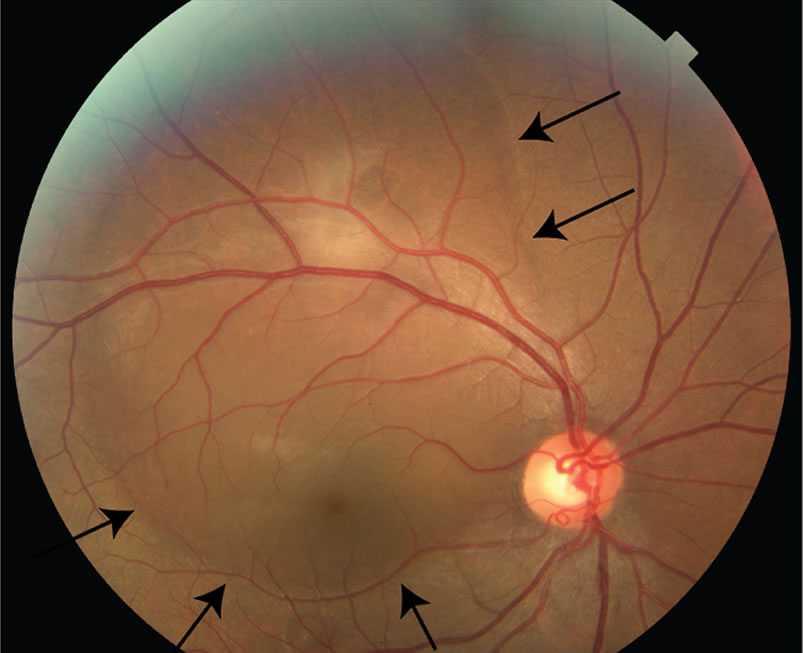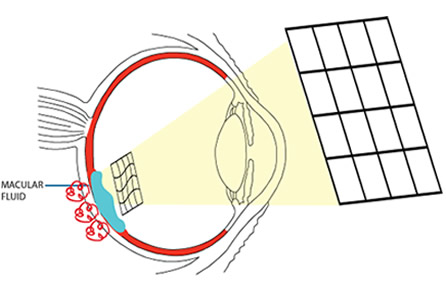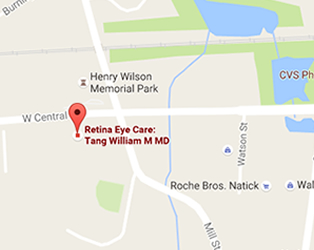Central Serous Retinopathy
Overview
Central Serous Retinopathy (CSR), also called Central Serous Chorioretinopathy (CSC), is a very common condition that affects the younger age group. It typically manifests a sudden onset of blurred vision or visual distortion in one eye without any pain. The main cause for CSR is probably anatomy. Patients with CSR often have a exuberant vasculature under the retina. This exuberant vasculature can start to leak fluid into the retina, especially when triggered by the use of corticosteroids products. The fluid in active CSR often resolves spontaneously in 3 months, which can seem like a long time if you are suffering from active CSR. Some patients can experience vision loss due to persistent fluid. A laser treatment can often be very effective in stopping the CSR fluid leakage.

central serous chorioretinopathy with a “blister” of fluid in the macula
Symptoms
Patients can develop blurred vision suddenly in one eye. It can look like wavy lines or an oval spot. The oval spot is fixed in relation to your visual world and does not exhibit any movement (unlike a floater, which often exhibit some movement). Many other more serious conditions can produce symptoms similar to this. So you should see your eye doctor or a retina specialist if you have these symptoms.
Risk Factors (Causes)
Central Serous Retinopathy (CSR) is a common condition. It occurs more commonly in men than in women. It tends to develop in patients with age < 55. The main factor that predicts the development of CSR is probably the vascular anatomy. CSR usually occurs in eyes that have a exuberant vasculature directly underneath the retina. For some reasons, these exuberant, dilated blood vessels start to leak fluid into the retina, and the fluid interferes with the normal functioning of the retina, and so the vision is affected. Often both eyes have these exuberant blood vessels. Patients with active CSR in one eye are often found to have signs of less active CSR in the other eye.
What triggers these blood vessels to leak fluid into the retina? No one knows for sure. Often there is no obvious trigger at all. The most common triggers are believed to be the use of corticosteroids products. CSR is probably related to some imbalance in the corticosteroids pathways in the body. Topical corticosteroids (like cortisone cream), inhalational corticosteroids (like Flonase), or corticosteroids injections are commonly associated with the development of active CSR. So if you are taking one of these corticosteroids products and you have CSR, you should discuss with your doctor what other options you may have.
There are numerous other associations with CSR. Many of them are related to corticosteroids metabolism. For example, patients with Type-A personality traits are more likely to develop CSR. Supposedly these patients also have a higher level of internal steroids in their system. CSR is associated with pregnancy, which is associated with an elevated level of natural steroids.
Living With Active CSR
Before the fluid in the retina would go away, either on its own or with treatment, you may have to learn to live with it during this time. It is often very distracting to go from having perfect vision to having blurred vision in one eye, especially if it is your dominant eye. You may have difficulty reading or working on the computer. You may feel that your depth perception is off. You may notice that the image size is different between the two eyes. Although it is theoretically possible to change your glasses to refocus your image on to the retina, it is impractical because the glasses prescription would change practically every day. With CSR, the fluid load in the retina often changes actively from day to day, and so some days the vision may seem better, and some days the vision may seem worse. In some cases, both eyes are simultaneously affected. If you have active CSR fluid, you should have the fluid monitored by your retina specialist until it goes away because if the fluid does not away, some vision loss may become permanent. Some patients can develop some vision loss even after the fluid goes away.
Treatment
If the fluid does not go away on its own, there are treatments available for CSR. Certain oral medications (e.g. eplerenone) can be used for the treatment of CSR, but the results are mixed, and the condition often recurs when the medications are discontinued. There are generally two types of laser treatment that can be used for active CSR — thermal laser photocoagulation, and photodynamic laser therapy (PDT) with Visudyne. PDT is commonly favored because it can shrink down the dilated blood vessels in the retina, thereby addressing the cause of the problem.



